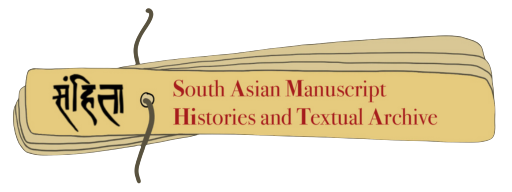Manuscripts
Search Filter
Ratnāvadānamālā.
ark:/12148/btv1b10082529k Language : Sanskrit Scripts : Devanagari
Avadāna is the name given to a type of Buddhist literature correlating past lives' virtuous deeds to subsequent lives' events.described them as "stories, usually narrated by the Buddha, that illustrate the workings of karma by revealing the acts of a particular individual in a previous life and the results of those actions in his or her present life In this manuscript the various stories are described .
Nirukta
ark:/12148/btv1b10083168m Language : Sanskrit Scripts : Devanagari
Nirukta is one of the six ancient Vedangas, or ancillary science connected with the Vedas the scriptures of Hinduism. Nirukta covers etymology, and is the study concerned with correct interpretation of Sanskrit words in the Vedas.The study of Nirukta has been closely related to the ancillary Vedic science of Vyakarana, but they have a different focus. Vyakarana deals with linguistic analysis to establish the exact form of words to properly express ideas, while Nirukta focuses on linguistic analysis to help establish the proper meaning of the words, given the context they are used in. this text is fourteen.
Ekapādikā-kāṇḍa.
ark:/12148/btv1b10083031v Language : Sanskrit Scripts : Devanagari
This Manuscript is on Brāhmaṇa grantha.
Lāṭyāyana-śrauta-sūtra.
ark:/12148/btv1b10083200x Language : Sanskrit Scripts : Devanagari
The Śrauta Sūtras form a very important unit of the Sūtras literature which lays down in brief the quintessence of the Vedic texts, i.e. the Saṁhitās and the Brāhmaṇas strengthening further the sacrificial tradition in India. The Lāṭyāyana-Śrauta-Sūtra is dealing with the duties of the chanting priests, the Udgātṛ, Prastotṛ, Pratihartṛ and Subrahmaṇya in the Śrauta ritual with special reference to the Soma sacrifice, belonging to the Kauthuma recension, of the Sāmaveda. Along with the duties of the chanters (Udgātṛ) in ekāha (one day), ahzna (multiday) and sattra (session), Soma sacrifices concerns with the role of the brāhmaṇa priest in Soma and various other sacrifices.
Saṃpuṭodbhava tantra.
ark:/12148/btv1b100823234 Language : Sanskrit Scripts : Devanagari
This Manuscript is on Nirvāṇa Phylosophy. This text desribed vajragarbhasādhu, Bodhisattva sādhu, Maākr̥pasādhu. This is a buddhist text .
Avadāna-śataka
ark:/12148/btv1b10082948g Language : Sanskrit Scripts : Newari
The Avadānaśataka or "Century of Noble Deeds (Avadāna)" is an anthology in Sanskrit of one hundred Buddhist legends. this is the name given to a type of Buddhist literature correlating past lives' virtuous deeds to subsequent lives' events.
Bhāgavatapurāṇa
ark:/12148/btv1b100828142 Language : Sanskrit Scripts : Devanagari
Bhagavata, is one of Hinduism's eighteen great Puranas (Mahapuranas). Composed in Sanskrit and traditionally attributed to Veda Vyasa, it promotes bhakti (devotion) towards Krishna, an avatar of Vishnu, integrating themes from the Advaita (monism) philosophy of Adi Shankara. This is a second adhyāya of Bhāgavatapurāṇa. This manuscript is with commentary.
Gṛhyasūtra of Gobhila.
ark:/12148/btv1b10083184n Language : Sanskrit Scripts : Devanagari
The Sutra of Gobhila presupposes, beside the Samhita of the Sama-veda, another collection of Mantras which evidently was composed expressly with the purpose of being used at Grihya ceremonies. Grihya-sutra, in Hinduism, any of a number of manuals detailing the domestic (grihya) religious ceremonies performed by both male and female householders over the fire.
Kalpadrumāvadāna
ark:/12148/btv1b100824813 Language : Sanskrit Scripts : Devanagari
Avadāna is the name given to a type of Buddhist literature correlating past lives' virtuous deeds to subsequent lives' events.described them as "stories, usually narrated by the Buddha, that illustrate the workings of karma by revealing the acts of a particular individual in a previous life and the results of those actions in his or her present life In this manuscript the various stories are described . Same in this manuscript various stories are desribed. This is A Collection of Legendary Stories about the Bodhisattvas.
Laṅkāvatāra
ark:/12148/btv1b10082293n Language : Sanskrit Scripts : Newari
It is a prominent Mahayana Buddhist sūtra. philosophical discourse in the Mahayana Buddhist tradition that is said to have been preached by the Buddha in the mythical city Lanka.The Lankavatara Sutra (“Sutra on the Descent to Lanka”) is an unsystematic and partial overview of the One Path teaching of Mahayana Buddhism. Its purpose is to lead advanced bodhisattvas to final self-realization, that is, to be a tathagata (see below). It recounts a visit the Buddha is said to have made to the island of Lanka, where he explained the Dharma to Sagara, a Serpent King, and later at the invitation of Rāvana, the king of the island of Lanka, to a vast assembly of advanced monks and bodhisattvas.
Ṛg-veda (padapāṭha
ark:/12148/btv1b100830168 Language : Sanskrit Scripts : Devanagari
This is a sūkta from R̥gvesda. The author wrote sūkta for the purpose of padapāth. The oral tradition of the Vedas (Śruti) consists of several pathas, "recitations" or ways of chanting the Vedic mantras its calles as padapāth. Udatta (middle tone), Anudaatta (lower tone), Svarita (higher tone) and Deergha Svarita (High tone extended). These are usually marked with intuitive svara marks an underline for lower tone, a small vertical line above the letter for a higher tone and two vertical lines for Deergha Svarita.
Ṛg-veda (padapāṭha)
ark:/12148/btv1b10083022w Language : Sanskrit Scripts : Devanagari
This is a sūkta from R̥gvesda. This is Agni sukta . This Sukta is the first sukta of R̥gveda. The oral tradition of the Vedas (Śruti) consists of several pathas, "recitations" or ways of chanting the Vedic mantras its calles as padapāth. Udatta (middle tone), Anudaatta (lower tone), Svarita (higher tone) and Deergha Svarita (High tone extended). These are usually marked with intuitive svara marks an underline for lower tone, a small vertical line above the letter for a higher tone and two vertical lines for Deergha Svarita.













